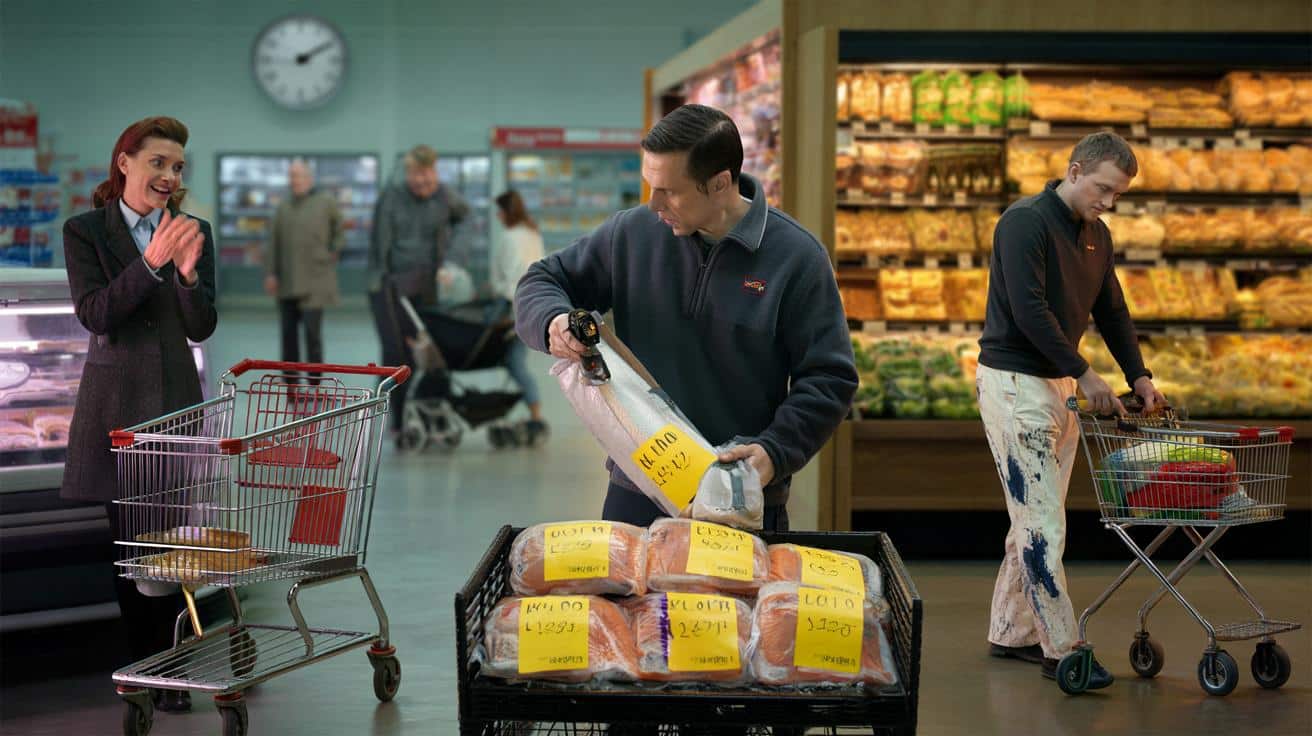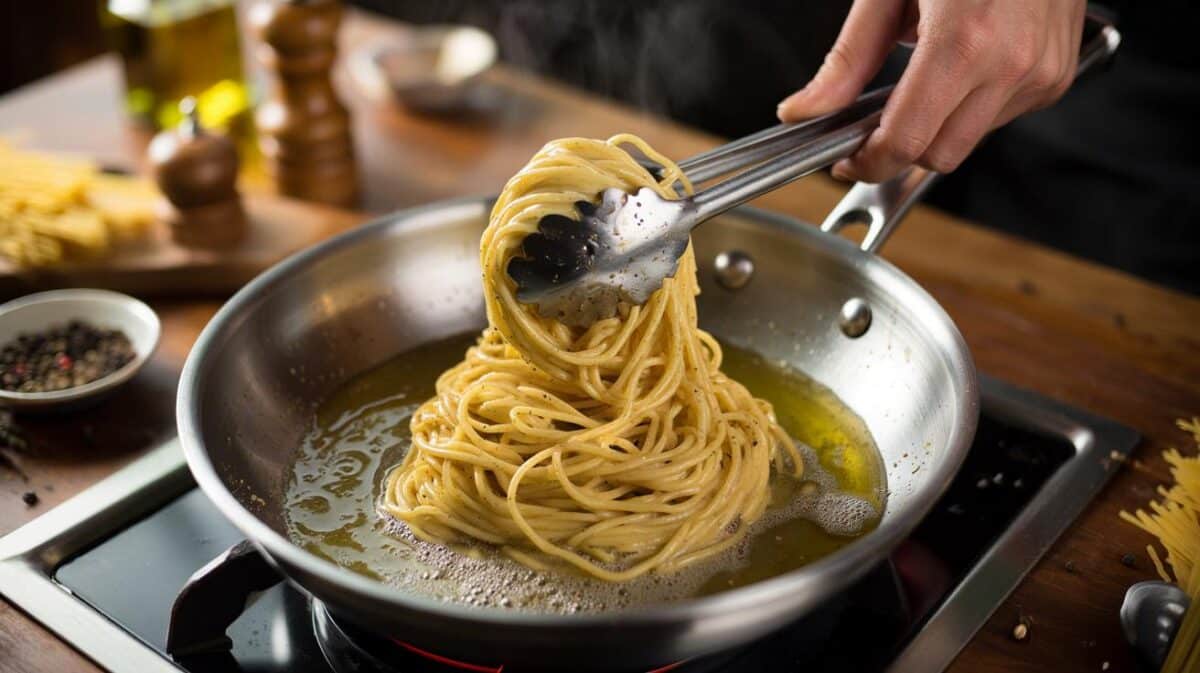A trolley clinks into view and the yellow stickers appear like fireflies. Prices that were stubborn an hour ago are suddenly soft, because the clock says those yoghurts and steaks and posh salads won’t see tomorrow. The bargains are real — but only if you hit the floor at the right time.
Two shoppers pretend to study the olives; a dad with a buggy lingers by the bakery like he’s remembering croissants in Paris. A colleague in a fleece smiles, sticks a new label on a pack of salmon, and the dance begins. I’m at a big Tesco in south London at 7.42pm and the price gun is singing. A yellow sticker drops a £5.50 pie to £1.38 and a woman in a smart coat gasps, properly. A man in paint-splattered trousers opens a tote and starts a quiet sweep. The air changes. The timing isn’t random.
The golden hour for yellow stickers
Supermarket insiders describe markdowns as a tide, not a lightning strike. First reductions often happen after lunch when managers clock what hasn’t moved, then a deeper round once the evening lull sets in and the use-by cliff gets close. Most final reductions land between 7pm and 8.30pm.
Listen to “Liam”, who worked nights at an Asda in Leeds: first stickers went on chilled bits about 12.30pm, then a harder chop at 5.30pm, and the proper “clear-the-fridge” crash at 8pm. He swears the biggest hauls always happened between 8.05 and 8.25, when ovens were off and queues light. I shadowed a student called Lily who walked out at 8.10 with a £28 steak for £3.40 and bagels for pennies. Her receipt showed a 73% saving. One trolley, one short window.
Why that window? Fresh teams build their rotas around sell-through and food safety rules, with a sweet spot when footfall dips but stock is still legal to sell. Nights with poor weather push it earlier because managers can see the write-off coming. Sundays pull everything forward since trading hours pinch the clock. Post-pandemic, 24-hour stores trimmed late-night operations, so the old 10pm jackpots often shifted back to 7–8.30pm. It’s logic more than luck.
Exact times, straight from staff rooms
Chain by chain, the clock looks like this, according to staff we spoke to: Tesco tends to fire final stickers 7–8.30pm; Sainsbury’s leans 6.30–7.30pm with a last sweep near close; M&S Food usually trims bakery at opening and hits chilled hard 5–7pm; Waitrose often goes deep 6–7.30pm. Morrisons runs a 3–5pm first pass, then a late knockdown around 7pm. Co-op is surprisingly punchy at 7–8.30pm. Asda, when staffed, pushes bold cuts 8–9pm. Aldi and Lidl are spikier, but many stores quietly sticker bakery just before shut.
Arrive ten minutes before the slot you’re aiming for, not thirty. That’s the difference between hovering and pouncing without fuss. We’ve all had that moment when the trolley appears and everyone pretends they weren’t waiting for it. Be kind at the sticker trolley — manners win more than elbows. Grab what you’ll actually cook, check the date, and think freezer first. Soyons honnêtes : personne ne fait vraiment ça tous les jours. Let’s be honest: nobody does that every day.
“There isn’t a secret club,” says Becks, a night-shift team leader at a Sainsbury’s in the Midlands. “Ask us when we’re planning the last round. We’d rather sell it to you for 80% off than bin it.”
Ask a staff member on fresh food: they usually know the clockwork.
- Tesco: 7–8.30pm final sweep; bakery markdowns often before 6pm.
- Sainsbury’s: 6.30–7.30pm deep cuts; milk/yoghurts can shift earlier on Sundays.
- Morrisons: first pass 3–5pm; big chops around 7pm.
- Waitrose: steady trims 5.30–7.30pm; deli can drop earlier midweek.
- Co-op: 7–8.30pm is prime; small stores go faster.
The mindset that wins the markdown game
You’re not chasing chaos — you’re matching the store’s rhythm. Turn up with a loose plan and a short list of “flex” dinners that welcome substitutions, like pasta with anything, traybakes, frittatas, soup. Yes, there’s a best time — and it’s earlier than you think. If there’s nothing good, walk out and try another night. The real saving lives in repeatable habits, not the unicorn haul you brag about once on Facebook.
Markdown hunting rewards curiosity, patience and a bit of local knowledge. Mondays and Tuesdays are calmer and can deliver tidy wins from weekend overstock; Fridays are louder and more competitive. Holidays tilt everything: bank holiday Mondays push big cuts to late afternoon; Christmas week sings in unpredictable waves. Ask, observe, and build your own map of your store’s pattern. The clock is consistent — once you learn its tick.
Stores also have rules within rules. Not all labels are equal: “use by” is a hard stop; “best before” is quality, not safety. Cook chilled meat or fish the same day or freeze it straight away. Cut fruit is rarely worth it unless you’re eating it tonight. Check the seal, peek under lids, and give packaging a once-over. Quiet confidence beats frantic grabbing, every time.
| Point clé | Détail | Intérêt pour le lecteur |
|---|---|---|
| The prime window | Most chains drop final stickers between 7pm and 8.30pm | Shows exactly when to walk in for the best odds |
| Chain nuances | Tesco/Sainsbury’s skew earlier than Asda; M&S/Waitrose focus on early evening | Helps tailor your run to the store you use |
| Smart tactics | Arrive 10 minutes early, ask staff, think freezer-friendly meals | Turns timing into actual savings you can eat |
FAQ :
- Do yellow-sticker times change on Sundays?Yes. Short trading hours pull reductions forward, often 4.30–6.30pm for deep cuts.
- Is it okay to ask for an extra markdown?Politely, yes. If it’s near closing and stock is still there, some colleagues will oblige. No promises.
- Are yellow-sticker foods safe?They follow the same safety rules. “Use by” means eat or freeze by that date. “Best before” is a quality guide.
- What should I do with big hauls?Freeze flat, label dates, and plan two fast-cook meals that use mixed bits — traybakes and soups love leftovers.
- Is there a secret markdown code?Not really. It’s staffing, footfall and dates. Your best “code” is knowing your store’s rhythm.










Tried the 7–8:30pm window at Tesco and walked out with a £1.20 salad and half‑price salmon. This article realy nailed it—thanks for the chain specifics!